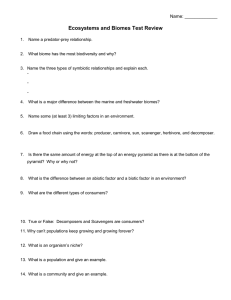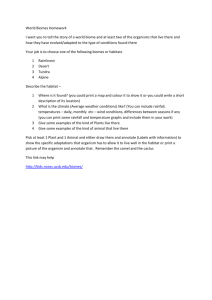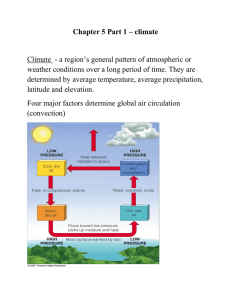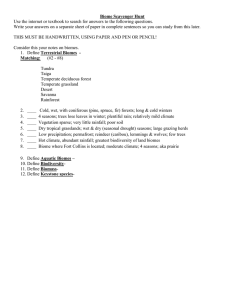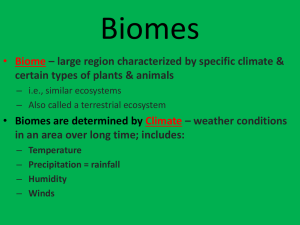Global Climates and Biomes
advertisement
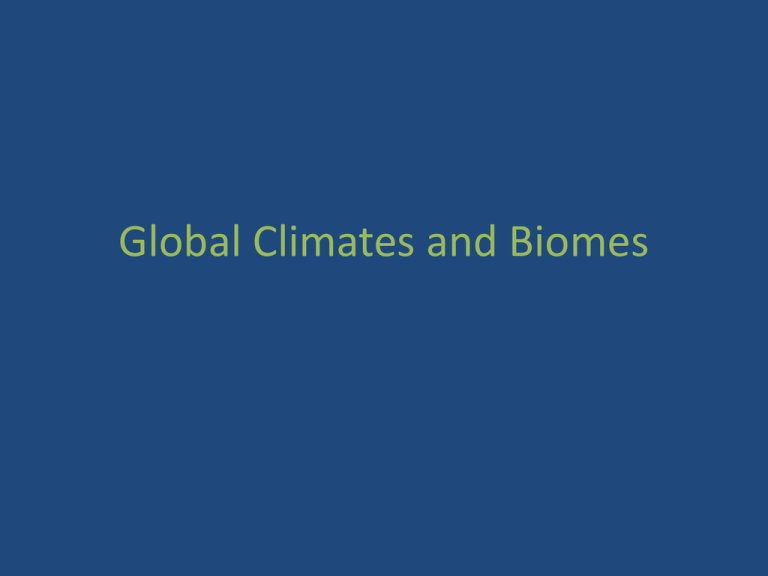
Global Climates and Biomes Weather v. Climate • Weather a. short-term conditions b. temperature, humidity, precipitation • Climate a. average weather that occurs in a certain region over a period of time b. based on temperature and precipitation Earth’s Atmosphere • Five layers of gases a. troposphere - N, O, and H2O vapor - location of weather b. stratosphere - ozone (O3) layer - absorbs the sun’s UV-B and UV-C radiation c. mesosphere d. thermosphere - blocks harmful x-ray and UV-radiation - Northern Lights e. exosphere Unequal Heating of Earth • 3 causes a. variation in angle of Sun ray’s striking Earth b. variation in surface area from sun’s rays distribution c. albedo: reflection of sunlight from Earth’s surface - higher the albedo, the more solar energy is reflected and less that is absorbed http://bcs.whfreeman.com/friedlandapes/#668210__690859__ Atmospheric Convection Currents • Air has 4 properties a. density b. water vapor capacity c. adiabatic heating or cooling d. latent heat release • Density a. determines air movement b. dense air sinks • Water Vapor Capacity a. saturation point - temperature of air decreases, vapor condenses, clouds form, precipitation occurs • Adiabatic Cooling and Heating a. response to change in pressure b. cooling - lower pressure of rising air allows air to expand resulting in lower temperature c. heating - air sinks, pressure increases decreasing in volume, and temperatures increase • Latent heat release a. energy is released when water vapor condenses into liquid water Convection Currents • Global patterns of air movement initiated by unequal heating of Earth • Hadley Cells a. air sinks at 30 degrees N and S • Polar Cells a. air sinks at 90 degrees N and S Coriolis Effect • Key component: Earth’s rotation a. faster rotation speed at equator - deflection of objects moving directly north and south ex) Earth rotates east, object goes west b. easterlies and westerlies http://bcs.whfreeman.com/friedlandapes/#668210__690859__ Earth’s Tilt and Seasons • Causes different parts of the Earth to experience different temperature and precipitation • Titled axis: 23.5 Ocean Currents • Driven by temperature, gravity, winds, Coriolis Effect and location of continents • Currents a. redistribute heat from the sun b. influence climate and vegetation • Gyres a. patterns of water circulation b. northern hemisphere: counterclockwise southern hemisphere: clockwise Upwelling • Bring plant nutrients from the deeper parts of the ocean to the surface • Support large populations of phytoplankton, zooplankton, fish, fish-eating seabirds El Nino-Southern Oscillation • Approx. every 3-7 years • Steps a. trade winds near S. America weaken b. allows warm equatorial water to move eastward toward the west coast of S. America c. suppresses upwelling off coast of Peru (decreases productivity) Rain Shadow • Windward side of mountain a. air rises, expands, cools, condenses, precipitates • Other side of mountain (rain shadow) a. air sinks, temps rise, dry weather http://en.wikipedia.org/wiki/Rain_shadow Biomes • Combination of temperature and precipitation • Contains distinct plant growth based on climate • Climate determines animal species • Climate diagrams • Climate Diagrams a. growing season b. relationship between temperature and plant growth http://mytriptothetundra.blogspot.com http://www.heritagechristian.ca/science/science7/climatograms.html Terrestrial Biomes • Three categories a. tundra and boreal forest b. temperate c. tropical * Within these, there are 9 biomes • Tundra a. cold and treeless with low-growing vegetation b. artic tundra, alpine tundra, antartic tundra c. short growing season d. permafrost – impermeable frozen soil layer e. slow decomposition http://www.marietta.edu/~biol/biomes/tundra.htm • Boreal Forest a. “Taiga” b. coniferous (cone-bearing) evergreen trees c. cold winters, short growing seasons d. slow decomposition http://www.marietta.edu/~biol/biomes/boreal.htm • Temperate Rainforest a. coastal biome b. 12-month growing season c. very large trees d. slow decomposition due to cool temps http://www.marietta.edu/~biol/biomes/temprain.htm • Temperate seasonal forest a. “deciduous forest” b. broadleaf deciduous trees c. four distinct seasons d. rapid decomposition e. greater productivity f. one of first biomes converted to agriculture http://www.marietta.edu/~biol/biomes/tempded.htm • Woodland/Shrubland a. “chaparral” – southern California b. hot dry summers, mild rainy winters c. 12-month growing season d. plant growth constrained by low precipitation in summer and low temperatures in winter e. poor nutrient soil http://apenvkretzer.wikispaces.com/Period+7 • Temperate Grassland/Cold Desert a. lowest average annual precipitation b. cold harsh winters, hot dry summers c. fires d. “cold desert” – rain shadow of Rocky Mtns e. nutrient rich soil http://www.marietta.edu/~biol/biomes/desert.htm • Tropical Rainforest a. warm and wet b. little seasonal variation c. high productivity d. rapid decomposition e. more biodiversity per hectare than any other terrestrial biome http://www.marietta.edu/~biol/biomes/troprain.htm • Tropical Seasonal Forest/Savanna a. warm temperatures b. distinct wet and dry seasons c. savannas: open landscapes dominated by grasses and scattered deciduous trees d. fertile soil = agriculture and grazing http://www.marietta.edu/~biol/biomes/tropdry.htm • Subtropical Desert a. 30 degrees N and S b. extremely dry c. sparse vegetation d. “hot deserts” http://www.marietta.edu/~biol/biomes/desert.htm Aquatic Biomes • Characterized by a. salinity b. depth c. water flow • Two Categories a. freshwater and saltwater (marine) • Streams and Rivers a. flowing fresh water b. streams: narrow, small amounts of water rivers: wide, large amounts of water c. inputs of organic matter http://www.johnharveyphoto.com/cgibin/search.pl?Advanced=2&SearchIncludesphotos=set&metaEnum Tag16=set&MetaTag16=160 http://savannahnow.com/news/2009-10-22/savannah-river-fourth-most-polluted-nation • Lakes and Ponds a. standing water b. distinct zones - littoral zone - limnetic zone - profundal zone - benthic zone http://www.ncparks.gov/Visit/parks/lano/main.php http://www.fcps.edu/islandcreekes/ecology/pond.htm • Freshwater Wetlands a. submerged by water for part of the year b. shallow enough to support vegetation c. swamps, marshes, and bogs d. highly productive providing ecosystem services http://medent.usyd.edu.au/arbovirus/mosquit/freshwet.htm • Salt Marshes a. along the coast (temperate) b. found in estuaries c. contain nonwoody emergent vegetation • Swamps a. along tropical and subtropical coasts b. mangrove trees (salt tolerant) - help protect coastlines from erosion and storm damage http://inchinapinch.com/hab_pgs/marine/mangrove/mangrove.htm • Coral Reefs a. found in warm, shallow water b. most diverse marine biome c. lives in water that’s poor in nutrients d. relationship with photosynthetic algae e. coral bleaching http://travel.nationalgeographic.com/travel/world-heritage/great-barrier-reef/ http://ocean.nationalgeographic.com/ocean/photos/ocean-corals/ • Open Ocean a. distinct zones - photic * photosynthesis - aphotic * lacks sunlight for photosynthesis * chemosynthesis - benthic * ocean floor http://cnx.org/content/m45562/latest / Terrestrial v. Aquatic Biomes Terrestrial Temperature and precipitation affect the rate of decomposition and productivity of soil Aquatic Differences in water flow, salinity and depth explain why different species of producers and consumers live in different regions

